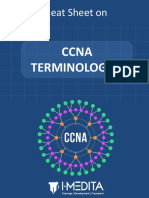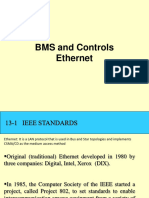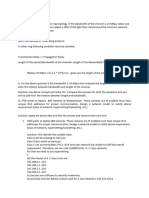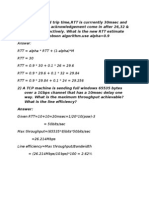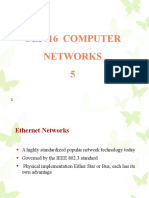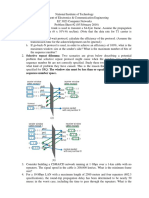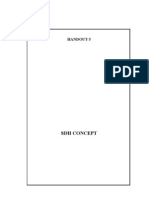Tutorial 1 - Introduction
Uploaded by
Bobby BeamanTutorial 1 - Introduction
Uploaded by
Bobby BeamanSoCP Tutorial
Introduction
SoCP Tutorial 1
To give you an idea of the environment in which networking devices are situated, we will investigate some key figures of current LAN/WAN transmission standards.
Exercise 1: IEEE 802.3 / Ethernet II LAN
a) Sketch the frame format of a plain IEEE 802.3 and Ethernet II frame including the lengths of all header/payload fields! What are the minimum/maximum frame and payload lengths? b) Consider the 100 Mbit/s Ethernet speed. What is the maximum sustainable payload transmission rate when using minimum/maximum payload fields lengths? Consider that the specification also requires an inter-frame gap of 12 bytes! c) What are the minimum/maximum payload transmission rates for 1 Gbit/s Ethernet and 10 Gbit/s Ethernet? d) For the dimensioning of packet processing infrastructure, the maximum packet rate is an important figure. Derive the numbers for the 100 Mbit/s, 1 Gbit/s and 10 Gbit/s variants of Ethernet. How many cycles can you spend processing per frame, if your circuit runs at 200 MHz?
Solution 1:
a) Ethernet II (DIX; DEC, Intel, Xerox): PRE 7 56 SFD DA 1 8 6 48 SA 6 48 Type Data 2 16 46-1500 368-12000 FCS IFG 4 32 12 96 bytes bit
Minimum frame: 72 (64) byte, 46 byte payload, (ratio: 63.9%, 54.7% w/ IFG) Maximum frame: 1526 (1518) byte, 1500 byte payload, (ratio: 98.3%, 97.5%) IEEE 802.3, identical except for Type, which is Length (2 bytes) => 802.2 SNAP as additional protocol necessary b) Mimimum frame size (w/IFG): 84 byte=672 bit per frame Frame rate: 100 Mbit/s / 672 bit/frame = 148,809.5 frames/s Data rate: 148,809.5 frames/s * (46*8) bit/frame = 54.76 Mbit/s see ratio! Maximum frame size: 100 Mbit/s / 12304 bit/frame * 12000 bit/frame = 97.53 Mbit/s 1 Institute for Integrated Systems, Technische Universitt Mnchen, 2013
SoCP Tutorial c) 1 Gbit/s: same frame format, constant overheads => scaling to 975.3 Mbit/s (@ max frame size) and 547.6 Mbit/s (@ min frame size) 10 Gbit/s: still same overheads => 9.753 Gbit/s (@ max frame size) 5.476 Gbit/s (@ min frame size)
Introduction
d) 100 Mbit/s: 100 Mbit/s / (84*8) bit/frame = 148,810 frames/s => IAT: 6.72 s 1 Gbit/s: 1000 Mbit/s / (84*8) bit/frame = 1,488,100 frames/s => IAT: 672 ns 10 Gbit/s: 10 Gbit/s / (84*8) bit/frame = 14,880,952 frames/s => IAT: 67.2 ns Processing budget in cycles for a 200 MHz circuit (5 ns): 100 Mbit/s: 1,344 cycles, 1 Gbit/s: 134 cycles, 10 Gbit/s: 13 cycles
Exercise 2: SONET/SDH and IP over AAL5/ATM over SONET
a) Sketch the frame format of an STM-1 SDH frame! Derive the total and payload data rates! b) What is the total overhead of a plain SDH transmission using STM-1 frames? How does it scale, when we move to STM-64? c) Among other possibilities, IP over ATM/AAL5 over SONET/SDH is a popular way for transporting IP packets over high-speed links in the backbone network. Determine the efficiency of ATM AAL5 transmission of a 40 byte, 46 byte and 1500 byte TCP/IP packet. d) Now you want to transmit IP packets (encapsulated in ATM/AAL5) over an STM256 (40Gbit/s) SDH link. What is the maximum throughput assuming transmission of 40 byte and 1500 byte packets respectively? e) Assume, that the SDH and ATM/AAL5 layers are terminated by respective framers in a Router line card. What is the instruction budget in clocks per packet, if we have a pipelined NP processor core with 16 processors running at 800 MHz each?
2 Institute for Integrated Systems, Technische Universitt Mnchen, 2013
SoCP Tutorial
Introduction
Solution 2:
a)
9 byte 1 byte 260 byte
OAM
P O H
Payload
9 rows
Total: 270*9*8 bit / 125 s = 155.520 Mbit/s Payload: 260*9*8 bit / 125 s = 149.760 Mbit/s b) 10*9*8 / 270*9*8 = 3.7% for STM-1 10*9*8*64 / 270*9*8*64 = 3.7% for STM-64 c) ATM-Cell:
5 byte Header 48 byte Payload
AAL5 PDU, which is sent in subsequent ATM cell payload sections:
(N*48-8) byte Payload Padding (if needed) 8 byte AAL5 Trailer
40 byte TCP/IP packet: AAL5 PDU contains 40B packet+8B trailer and fits into one 53B ATM cell => 40B/53B = 75.47% 46 byte TCP/IP packet (could come from an Ethernet frame): AAL5 PDU contains 46B packet+42B padding+8B trailer and fits into 2 ATM cells => 46B/106B = 43.40% 1500 byte TCP/IP packet: AAL5 PDU contains 1500B packet+28B padding+8B trailer and fits into 32 ATM cells => 1500B/(32*53B)=88.44% d) STM-256 payload rate: 256*260*9*8 bit/125 s = 38.338560 Gbit/s The payload is now filled with 40 byte or 1500 byte encapsulated payloads (efficiency from c)): 40 byte: 75.47% * 38.338560 Gbit/s = 28.93 Gbit/s 1500 byte: 88.44% * 38.338560 Gbit/s = 33.91 Gbit/s 3 Institute for Integrated Systems, Technische Universitt Mnchen, 2013
SoCP Tutorial e) Processor clock period: 1/800 MHz = 1.25 ns 40 byte packets: coming in at 28.93 Gbit/s from the framers Time budget: 40*8 bit / 28.93 Gbit/s = 11.06 ns per packet 16 processors: 16*floor(11.06 ns/1.25 ns)=128 cycles 1500 byte packets: coming in at 33.91 Gbit/s from the framers Time budget: 1500*8 bit / 33.91 Gbit/s = 353.88 ns per packet
Introduction
16 processors: 16*floor(353.88 ns/1.25 ns)=4,528 cycles, which is far more relaxed than for the 40B packets!
4 Institute for Integrated Systems, Technische Universitt Mnchen, 2013
You might also like
- Graded Recitation - Ethernet Chap4.3 Tanenbaum 2011 EditionNo ratings yetGraded Recitation - Ethernet Chap4.3 Tanenbaum 2011 Edition1 page
- Part 3: The Medium Access Control SublayerNo ratings yetPart 3: The Medium Access Control Sublayer36 pages
- 40-100gigabitethernettechnologyoverview-160208103505No ratings yet40-100gigabitethernettechnologyoverview-16020810350510 pages
- 0BzHu7MURhtkHbWxyZk9wRWpSTXJhLTNMUVZvR0dHNHZfajBj 1 PDFNo ratings yet0BzHu7MURhtkHbWxyZk9wRWpSTXJhLTNMUVZvR0dHNHZfajBj 1 PDF2 pages
- Slot C - CSA07 - Computer Networks - Tutorial HourNo ratings yetSlot C - CSA07 - Computer Networks - Tutorial Hour22 pages
- Transmission Is The Act of Transporting Information From One Location To Another Via A SignalNo ratings yetTransmission Is The Act of Transporting Information From One Location To Another Via A Signal55 pages
- General Comments On Candidates' PerformanceNo ratings yetGeneral Comments On Candidates' Performance10 pages
- Wired Lans and Ethernet: 01204325: Data Communication and Computer NetworksNo ratings yetWired Lans and Ethernet: 01204325: Data Communication and Computer Networks53 pages
- Ethernet and Switches (Computer Network)No ratings yetEthernet and Switches (Computer Network)31 pages
- Ceragon - Jumbo Frames - Technical BriefNo ratings yetCeragon - Jumbo Frames - Technical Brief7 pages
- Computer Networks Computer Networks: Taiz University, 2021 Taiz University, 2021No ratings yetComputer Networks Computer Networks: Taiz University, 2021 Taiz University, 202154 pages
- Simple Capacity Estimations in Wimax/802.16 System: Loutfi Nuaymi, Ziad NounNo ratings yetSimple Capacity Estimations in Wimax/802.16 System: Loutfi Nuaymi, Ziad Noun5 pages
- Ethernet: Fast Ethernet Gigabit EthernetNo ratings yetEthernet: Fast Ethernet Gigabit Ethernet47 pages
- Difference Between Ethernet 2 Frame and 802.3 Frame0% (1)Difference Between Ethernet 2 Frame and 802.3 Frame2 pages
- Study The MAC Solution IEEE802.15.4 For Wireless Sensor NetworksNo ratings yetStudy The MAC Solution IEEE802.15.4 For Wireless Sensor Networks35 pages
- Data and Computer Communications: Chapter 16 - High Speed LansNo ratings yetData and Computer Communications: Chapter 16 - High Speed Lans41 pages
- Компјутерски мрежи скрипта II кол. (КНИА)No ratings yetКомпјутерски мрежи скрипта II кол. (КНИА)62 pages
- Chip Multicore Processors - Tutorial 10: Task 10.1: Why On-Chip Coherence Is Here To StayNo ratings yetChip Multicore Processors - Tutorial 10: Task 10.1: Why On-Chip Coherence Is Here To Stay2 pages
- Chip Multicore Processors - Tutorial 11: Task 11.1: RoutingNo ratings yetChip Multicore Processors - Tutorial 11: Task 11.1: Routing2 pages
- Chip Multicore Processors - Tutorial 8: Task 8.1: Performance of Snooping-Based Cache CoherencyNo ratings yetChip Multicore Processors - Tutorial 8: Task 8.1: Performance of Snooping-Based Cache Coherency3 pages
- Chip Multicore Processors - Tutorial 7: Task 7.1: Memory Overhead of Cache CoherencyNo ratings yetChip Multicore Processors - Tutorial 7: Task 7.1: Memory Overhead of Cache Coherency2 pages
- Chip Multicore Processors - Tutorial 6: Task 6.1: Cache MissesNo ratings yetChip Multicore Processors - Tutorial 6: Task 6.1: Cache Misses1 page
- Chip Multicore Processors - Tutorial 5: Task 5.1: SemaphoresNo ratings yetChip Multicore Processors - Tutorial 5: Task 5.1: Semaphores1 page
- Chip Multicore Processors - Tutorial 4: Task 4.1: Counter ImplementationNo ratings yetChip Multicore Processors - Tutorial 4: Task 4.1: Counter Implementation1 page
- Chip Multicore Processors - Tutorial 3: 3.1: 3-Thread LockNo ratings yetChip Multicore Processors - Tutorial 3: 3.1: 3-Thread Lock2 pages
- Chip Multicore Processors - Tutorial 2: 2.1: Frequency and Voltage Scaling, Amdahl's LawNo ratings yetChip Multicore Processors - Tutorial 2: 2.1: Frequency and Voltage Scaling, Amdahl's Law2 pages
- Final Exam System On Chip Solutions in Networking SS 2010No ratings yetFinal Exam System On Chip Solutions in Networking SS 201012 pages
- 2008 FinalExam SoCN Final Master SolutionNo ratings yet2008 FinalExam SoCN Final Master Solution10 pages
- Final Exam System On Chip Solutions in Networking SS 2007No ratings yetFinal Exam System On Chip Solutions in Networking SS 200710 pages
- 2013 Anz PDF BRKCOM-1001 - UCS Fabric FundamentalsNo ratings yet2013 Anz PDF BRKCOM-1001 - UCS Fabric Fundamentals72 pages
- RTN 950 V100R003C03 Maintenance Guide 05 (U2000)100% (1)RTN 950 V100R003C03 Maintenance Guide 05 (U2000)834 pages
- Recommendations: Huawei Learning WebsiteNo ratings yetRecommendations: Huawei Learning Website310 pages
- t-berd-mts-5800-ethernet-bit-error-rate-testing-bert-quick-references-enNo ratings yett-berd-mts-5800-ethernet-bit-error-rate-testing-bert-quick-references-en5 pages
- BG-20B/E: Miniature Optical Service Access PlatformNo ratings yetBG-20B/E: Miniature Optical Service Access Platform6 pages
- Bro - ibaPDA Allen Bradley Connectivity - enNo ratings yetBro - ibaPDA Allen Bradley Connectivity - en8 pages
- Lab 3-2 Modifying Default Spanning Tree Behavior: ObjectiveNo ratings yetLab 3-2 Modifying Default Spanning Tree Behavior: Objective12 pages
- (Ebooks PDF) Download Data Communications and Networking With TCP/IP Protocol Suite 6th Edition Behrouz A. Forouzan Full Chapters100% (2)(Ebooks PDF) Download Data Communications and Networking With TCP/IP Protocol Suite 6th Edition Behrouz A. Forouzan Full Chapters49 pages
- 29 SS 654 Traffic Signal Systems Sep 07 2011No ratings yet29 SS 654 Traffic Signal Systems Sep 07 201147 pages
- VCB8020Lahti Precision WA810 Communication Manual EN PDFNo ratings yetVCB8020Lahti Precision WA810 Communication Manual EN PDF39 pages
- Cpri Ip Core: FPGA-IPUG-02029 Version 2.8No ratings yetCpri Ip Core: FPGA-IPUG-02029 Version 2.851 pages
- OSN 3500-00449022-Maintenance Cases (V100R008 - 01)100% (1)OSN 3500-00449022-Maintenance Cases (V100R008 - 01)103 pages
- Tech Bulletin 270 (Rev7) - Solving CNCPC To MPU Communication ErrorsNo ratings yetTech Bulletin 270 (Rev7) - Solving CNCPC To MPU Communication Errors7 pages
- Graded Recitation - Ethernet Chap4.3 Tanenbaum 2011 EditionGraded Recitation - Ethernet Chap4.3 Tanenbaum 2011 Edition
- 40-100gigabitethernettechnologyoverview-16020810350540-100gigabitethernettechnologyoverview-160208103505
- 0BzHu7MURhtkHbWxyZk9wRWpSTXJhLTNMUVZvR0dHNHZfajBj 1 PDF0BzHu7MURhtkHbWxyZk9wRWpSTXJhLTNMUVZvR0dHNHZfajBj 1 PDF
- Slot C - CSA07 - Computer Networks - Tutorial HourSlot C - CSA07 - Computer Networks - Tutorial Hour
- Transmission Is The Act of Transporting Information From One Location To Another Via A SignalTransmission Is The Act of Transporting Information From One Location To Another Via A Signal
- Wired Lans and Ethernet: 01204325: Data Communication and Computer NetworksWired Lans and Ethernet: 01204325: Data Communication and Computer Networks
- Computer Networks Computer Networks: Taiz University, 2021 Taiz University, 2021Computer Networks Computer Networks: Taiz University, 2021 Taiz University, 2021
- Simple Capacity Estimations in Wimax/802.16 System: Loutfi Nuaymi, Ziad NounSimple Capacity Estimations in Wimax/802.16 System: Loutfi Nuaymi, Ziad Noun
- Difference Between Ethernet 2 Frame and 802.3 FrameDifference Between Ethernet 2 Frame and 802.3 Frame
- Study The MAC Solution IEEE802.15.4 For Wireless Sensor NetworksStudy The MAC Solution IEEE802.15.4 For Wireless Sensor Networks
- Data and Computer Communications: Chapter 16 - High Speed LansData and Computer Communications: Chapter 16 - High Speed Lans
- CCST Cisco Certified Support Technician Study Guide: Networking ExamFrom EverandCCST Cisco Certified Support Technician Study Guide: Networking Exam
- Chip Multicore Processors - Tutorial 10: Task 10.1: Why On-Chip Coherence Is Here To StayChip Multicore Processors - Tutorial 10: Task 10.1: Why On-Chip Coherence Is Here To Stay
- Chip Multicore Processors - Tutorial 11: Task 11.1: RoutingChip Multicore Processors - Tutorial 11: Task 11.1: Routing
- Chip Multicore Processors - Tutorial 8: Task 8.1: Performance of Snooping-Based Cache CoherencyChip Multicore Processors - Tutorial 8: Task 8.1: Performance of Snooping-Based Cache Coherency
- Chip Multicore Processors - Tutorial 7: Task 7.1: Memory Overhead of Cache CoherencyChip Multicore Processors - Tutorial 7: Task 7.1: Memory Overhead of Cache Coherency
- Chip Multicore Processors - Tutorial 6: Task 6.1: Cache MissesChip Multicore Processors - Tutorial 6: Task 6.1: Cache Misses
- Chip Multicore Processors - Tutorial 5: Task 5.1: SemaphoresChip Multicore Processors - Tutorial 5: Task 5.1: Semaphores
- Chip Multicore Processors - Tutorial 4: Task 4.1: Counter ImplementationChip Multicore Processors - Tutorial 4: Task 4.1: Counter Implementation
- Chip Multicore Processors - Tutorial 3: 3.1: 3-Thread LockChip Multicore Processors - Tutorial 3: 3.1: 3-Thread Lock
- Chip Multicore Processors - Tutorial 2: 2.1: Frequency and Voltage Scaling, Amdahl's LawChip Multicore Processors - Tutorial 2: 2.1: Frequency and Voltage Scaling, Amdahl's Law
- Final Exam System On Chip Solutions in Networking SS 2010Final Exam System On Chip Solutions in Networking SS 2010
- Final Exam System On Chip Solutions in Networking SS 2007Final Exam System On Chip Solutions in Networking SS 2007
- 2013 Anz PDF BRKCOM-1001 - UCS Fabric Fundamentals2013 Anz PDF BRKCOM-1001 - UCS Fabric Fundamentals
- t-berd-mts-5800-ethernet-bit-error-rate-testing-bert-quick-references-ent-berd-mts-5800-ethernet-bit-error-rate-testing-bert-quick-references-en
- BG-20B/E: Miniature Optical Service Access PlatformBG-20B/E: Miniature Optical Service Access Platform
- Lab 3-2 Modifying Default Spanning Tree Behavior: ObjectiveLab 3-2 Modifying Default Spanning Tree Behavior: Objective
- (Ebooks PDF) Download Data Communications and Networking With TCP/IP Protocol Suite 6th Edition Behrouz A. Forouzan Full Chapters(Ebooks PDF) Download Data Communications and Networking With TCP/IP Protocol Suite 6th Edition Behrouz A. Forouzan Full Chapters
- VCB8020Lahti Precision WA810 Communication Manual EN PDFVCB8020Lahti Precision WA810 Communication Manual EN PDF
- OSN 3500-00449022-Maintenance Cases (V100R008 - 01)OSN 3500-00449022-Maintenance Cases (V100R008 - 01)
- Tech Bulletin 270 (Rev7) - Solving CNCPC To MPU Communication ErrorsTech Bulletin 270 (Rev7) - Solving CNCPC To MPU Communication Errors

